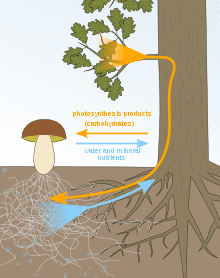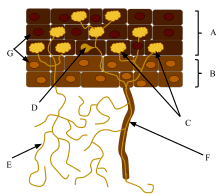I wanted to clarify what I meant by you don't need mychos. Don't get me wrong they are great to have. But with that said mycho's are typically found in soils that are deficient in npk or micro nutes. Thats when they will colonize as an extension of the rhizosphere and reach out for nutes that are lacking that the plant needs.
If your using good soil you dont need them. Thats what I meant.
isnt it also a "safety net"
Mycorrhizal fungi form a
mutualistic relationship with the roots of most plant species. In such a relationship, both the plants themselves and those parts of the roots that host the fungi, are said to be mycorrhizal. Relatively few of the mycorrhizal relationships between plant species and fungi have been examined to date, but 95% of the plant families investigated are predominantly mycorrhizal either in the sense that most of their species associate beneficially with mycorrhizae, or are absolutely dependent on mycorrhizae. The
Orchidaceae are notorious as a family in which the absence of the correct mycorrhizae is fatal even to germinating seeds.
[26]
Recent research into
ectomycorrhizal plants in
boreal forests has indicated that mycorrhizal fungi and plants have a relationship that may be more complex than simply mutualistic. This relationship was noted when mycorrhizal fungi were unexpectedly found to be hoarding nitrogen from plant roots in times of nitrogen scarcity. Researchers argue that some mycorrhizae distribute nutrients based upon the environment with surrounding plants and other mycorrhizae. They go on to explain how this updated model could explain why mycorrhizae do not alleviate plant nitrogen limitation, and why plants can switch abruptly from a mixed strategy with both mycorrhizal and nonmycorrhizal roots to a purely mycorrhizal strategy as soil nitrogen availability declines.
[27] It has also been suggested that evolutionary and phylogenetic relationships can explain much more variation in the strength of mycorrhizal mutualisms than ecological factors.
[28]

Within mutualistic mycorrhiza, the plant gives carbohydrates (products of photosynthesis) to the fungus, while the fungus gives the plant water and minerals in exchange.
Sugar-water/mineral exchange

In this mutualism, fungal hyphae (E) increase the surface area of the root and uptake of key nutrients while the plant supplies the fungi with fixed carbon (A=root cortex, B=root epidermis, C=arbuscle, D=vesicle, F=root hair, G=nuclei).</ref>
The mycorrhizal mutualistic association provides the fungus with relatively constant and direct access to
carbohydrates, such as
glucose and
sucrose.
[29] The carbohydrates are translocated from their source (usually leaves) to root tissue and on to the plant's fungal partners. In return, the plant gains the benefits of the
mycelium's higher absorptive capacity for water and mineral nutrients, partly because of the large surface area of fungal hyphae, which are much longer and finer than plant
root hairs, and partly because some such fungi can mobilize soil minerals unavailable to the plants' roots. The effect is thus to improve the plant's mineral absorption capabilities.
[30]
Unaided plant roots may be unable to take up
nutrients that are chemically or physically
immobilised; examples include
phosphate ions and
micronutrients such as iron. One form of such immobilization occurs in soil with high
clay content, or soils with a strongly
basic pH. The
mycelium of the mycorrhizal fungus can, however, access many such nutrient sources, and make them available to the plants they colonize.
[31] Thus, many plants are able to obtain phosphate, without using soil as a source. Another form of immobilisation is when nutrients are locked up in organic matter that is slow to decay, such as wood, and some mycorrhizal fungi act directly as decay organisms, mobilising the nutrients and passing some onto the host plants; for example, in some
dystrophic forests, large amounts of phosphate and other nutrients are taken up by mycorrhizal
hyphae acting directly on leaf litter, bypassing the need for soil uptake.
[32] Inga alley cropping, proposed as an alternative to
slash and burn rainforest destruction,
[33] relies upon mycorrhiza within the root system of species of
Inga to prevent the rain from washing
phosphorus out of the soil.
[34]
In some more complex relationships, mycorrhizal fungi do not just collect immobilised soil nutrients, but connect individual plants together by
mycorrhizal networks that transport water, carbon, and other nutrients directly from plant to plant through underground hyphal networks.
[35]
Suillus tomentosus, a
basidiomycete fungus, produces specialized structures known as tuberculate ectomycorrhizae with its plant host
lodgepole pine (
Pinus contorta var.
latifolia). These structures have been shown to host
nitrogen fixing bacteria which contribute a significant amount of
nitrogen and allow the pines to colonize nutrient-poor sites.
[36]
Mechanisms
The mechanisms by which mycorrhizae increase absorption include some that are physical and some that are chemical. Physically, most mycorrhizal mycelia are much smaller in diameter than the smallest root or root hair, and thus can explore soil material that roots and root hairs cannot reach, and provide a larger surface area for absorption. Chemically, the cell membrane chemistry of fungi differs from that of plants. For example, they may secrete
organic acids that dissolve or
chelate many ions, or release them from minerals by
ion exchange.
[37] Mycorrhizae are especially beneficial for the plant partner in nutrient-poor soils.
[38]
Disease, drought and salinity resistance and its correlation to mycorrhizae
Mycorrhizal plants are often more resistant to diseases, such as those caused by microbial soil-borne
pathogens. These associations have been found to assist in plant defense both above and belowground. Mycorrhizas have been found to excrete enzymes that are toxic to soil borne organisms such as nematodes.
[39] More recent studies have shown that mycorrhizal associations result in a priming effect of plants that essentially acts as a primary immune response. When this association is formed a defense response is activated similarly to the response that occurs when the plant is under attack. As a result of this inoculation, defense responses are stronger in plants with mycorrhizal associations.
[40]
AMF was also significantly correlated with soil biological fertility variables such as soil microbial communities and associated disease suppressiveness.
[41] Thus,
ecosystem services provided by AMF may depend on the soil microbiome.
[41] Furthermore, AMF was significantly correlated with soil physical variable, but only with water level and not with aggregate stability.
[42][43] and are also more resistant to the effects of drought.
[44][45][46] The significance of arbuscular mycorrhizal fungi includes alleviation of salt stress and its beneficial effects on plant growth and productivity. Although salinity can negatively affect arbuscular mycorrhizal fungi, many reports show improved growth and performance of mycorrhizal plants under salt stress conditions.
[47]
Resistance to insects
Research has shown that plants connected by mycorrhizal fungi can use these underground connections to produce and receive warning signals.
[48][49] Specifically, when a host plant is attacked by an
aphid, the plant signals surrounding connected plants of its condition. The host plant releases
volatile organic compounds (VOCs) that attract the insect's predators. The plants connected by mycorrhizal fungi are also prompted to produce identical VOCs that protect the uninfected plants from being targeted by the insect.
[48] Additionally, this assists the mycorrhizal fungi by preventing the plant's carbon relocation which negatively affects the fungi's growth and occurs when the plant is attacked by herbivores.
[48]
Colonization of barren soil
Plants grown in sterile
soils and growth media often perform poorly without the addition of
spores or hyphae of mycorrhizal fungi to colonise the plant roots and aid in the uptake of soil mineral nutrients.
[50] The absence of mycorrhizal fungi can also slow plant growth in early succession or on degraded landscapes.
[51] The introduction of alien mycorrhizal plants to nutrient-deficient ecosystems puts indigenous non-mycorrhizal plants at a competitive disadvantage.
[52] This aptitude to colonize barren soil is defined by the category
Oligotroph.
Resistance to toxicity
Fungi have been found to have a protective role for plants rooted in soils with high metal concentrations, such as
acidic and
contaminated soils.
Pine trees inoculated with
Pisolithus tinctorius planted in several contaminated sites displayed high tolerance to the prevailing contaminant, survivorship and growth.
[53] One study discovered the existence of
Suillus luteus strains with varying tolerance of
zinc. Another study discovered that zinc-tolerant strains of
Suillus bovinus conferred resistance to plants of
Pinus sylvestris. This was probably due to binding of the metal to the extramatricial
mycelium of the fungus, without affecting the exchange of beneficial substances.
[52]
Climate change
This section is an excerpt from
Mycorrhizae and climate change.
[edit]
Mycorrhizae and climate change refers to the
effects of climate change on
mycorrhizae, a
fungus which forms an
endosymbiotic relationship between with a
vascular host plant[54] by colonizing its roots, and the effects brought on by
climate change. Climate change is any lasting effect in weather or temperature. It is important to note that a good indicator of climate change is
global warming, though the two are not analogous.
[55] However, temperature plays a very important role in all ecosystems on Earth, especially those with high counts of mycorrhiza in
soil biota.
Mycorrhizae are one of the most widespread symbioses on the planet, as they form a plant-fungal interaction with nearly eighty percent of all terrestrial plants.
[56] The resident mycorrhizae benefits from a share of the sugars and carbon produced during photosynthesis, while the plant effectively accesses water and other nutrients, such as nitrogen and phosphorus, crucial to its health.
[57] This symbiosis has become so beneficial to
terrestrial plants that some depend entirely on the relationship to sustain themselves in their respective environments. The fungi are essential to the planet as most ecosystems, especially those in the
Arctic, are filled with plants that survive with the aid of mycorrhizae. Because of their importance to a productive ecosystem, understanding this fungus and its symbioses is currently an active area of scientific research.







